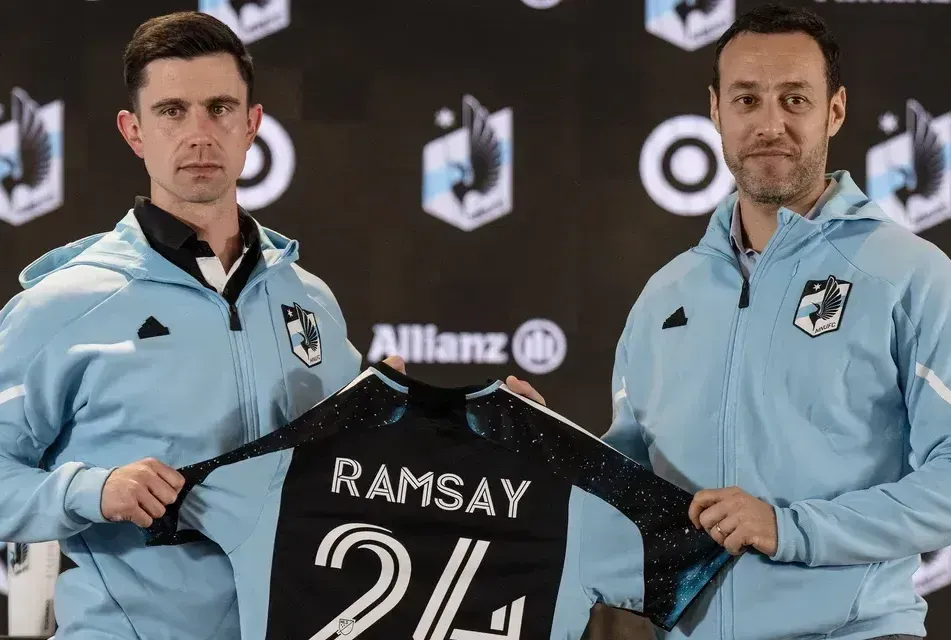Weeks before a 2-1 win over New York City FC at Yankee Stadium to extend their unbeaten streak to five straight matches, Minnesota United FC made waves in American soccer circles for a different, off-field reason.
The club formalized a consulting partnership with American Soccer Analysis (ASA), a soccer analytics-focused website founded in 2013, with the separate-from-the-website consulting arm of ASA meant to help Minnesota with player recruitment.
A recent Minnesota Star Tribune article about the ASA-Loons partnership included a quote from ASA consultant Mike Imburgio describing their work, with Imburgio saying "Our goal is really to gather and analyze as much information as possible on prospective players...to build the most complete picture of a player we can, from as many different angles as we can, before any decisions are made."
It's all part of a shift by Minnesota to become a "data-based organization" under its new leadership team of Chief Soccer Officer Khaled El-Ahmad and Head Coach Eric Ramsay, and it makes the Loons one of a growing set of Major League Soccer teams making moves to embrace data and analytics.
More teams are doing that by building or expanding their internal analytics operations, working with outside consultants like Minnesota with ASA, or even, in the cases of San Diego FC and Colorado Rapids, putting executives with strong backgrounds in data and analytics in charge of their entire sporting operation.
It's not just the wealthiest and best-connected teams in MLS, like those a part of multi-club ownership conglomerates such as New York City FC under the umbrella of City Football Group, driving this shift.
The number of teams that "pretty stubbornly refused to hire analytics staff," which ASA tracks as part of their own annual "State of MLS Analytics" feature, is smaller and could potentially shrink further as more organizations undergo leadership and strategy changes like the ones Minnesota recently made – looking at you, Sporting Kansas City, now that the reign of Peter Vermes has ended.
Since its 2013 founding, ASA the website has been an invaluable resource in the space of American soccer stats, data, analytics, and analysis, so we spoke to ASA writer Kieran Doyle-Davis in an attempt to learn more about all that's changed and all that might still be to come in the realm of MLS analytics.
Spend smart or get left behind
The days of MLS front-office executives going onto Transfermarkt and searching for members of the Italian national team to sign could become a thing of the past, if for no reason other than a desire among MLS owners and front offices to avoid embarrassment.
Teams don't want to be seen as the Luddites in the room, and according to Doyle-Davis, being singled out for not embracing analytics or modern soccer data can be a catalyst. "Teams and owners mostly really care about not being at the bottom. It's a negative way to frame it, but the chiding of being in the bottom tiers has pushed organizations to hire people," Doyle-Davis says.
The "bottom tiers" in this case are comprised of MLS teams with zero or just one data and analytics-focused staff. Minnesota United is still down near the bottom of ASA's analytical team rankings, but they also spent the first seven seasons of their MLS existence led solely by Adrian Heath as Head Coach and, since 2019, with one of Heath's longtime assistant coaches, Mark Watson, serving as Technical Director – all while having zero analytics-focused staffers on the payroll, and with diminishing on-field returns by 2023 when they fired both Heath and Watson.
The partnership between ASA and Minnesota reportedly began informally when the Heath regime left the picture in the fall of 2023, and the Loons have been savvy in their team-building since, signing players – like Argentine playmaker Joaquin Pereyra or Italian striker Kelvin Yeboah – from a wider variety of quality leagues than they did under Heath.
"We see a pretty consistent trend that even a cursory investment in analytics in MLS helps you win. Given how equal MLS is, spending smart or spending stupid is impactful, putting budget into things that generate you edge outside of players is effective," says Doyle-Davis of ASA.
MLS teams are more valuable than they have ever been, and the league has assembled a stable base of club owners who have the kinds of deep pockets necessary to foot the bill for expanded spending on data and analytics operations. New York City FC, as an example, benefits from the expansive City Football Group scouting network as well as CFG's existing data and analysis infrastructure, though the team also employs its own analysts and data folks.
Endlessly rich multi-club-model teams like NYCFC are facing more competition than ever as more MLS teams start spending on data and analytics operations. The financial and infrastructure advantages once baked into the ownership models of teams like NYCFC, the Red Bulls, or even the smaller multi-club groups like those controlling LAFC and Chicago Fire FC, disappear as more MLS owners beef up their internal data operations. In a league where parity reigns and financial rules are stringent, spending more on analytics could be seen as another way for the "smaller fish" in MLS to keep up with the proverbial sharks.
"The nice thing is MLS clubs are comparatively very wealthy for where they sit in the global hierarchy. It would be very easy for them to become much smarter and better buyers than Turkey, Portugal, Belgium, the Netherlands, and clubs of a similar ilk," says Doyle-Davis.
Progress still to be made
Some MLS teams are more bought-in than others. Expansion franchise San Diego FC is an example of a club all-in, with a top soccer executive, 33-year-old Tyler Heaps, plucked straight from the world of data and analytics. Heaps served as Head of Analysis and Insights at AS Monaco Football Club in France from 2021 to 2023, and he appears to have built an instant contender with San Diego, who are off to one of the best-ever starts among any MLS expansion teams.
"An analytics person getting control of an organization a decade ago was just not a realistic ask...Analytics departments are fairly fledgling enterprises in MLS," says Doyle-Davis, so Heaps and his San Diego operation are still very much the exception.
Even despite progress, most MLS teams still don't employ sizable analytics departments, and it's a slow march forward as the league's few data-centric staffers try to climb up their organizational ladders to replicate the rise of someone like Heaps in San Diego.
The work-in-progress nature of analytics acceptance in MLS also came up during the latest installment of an annual anonymous survey of MLS executives conducted by The Athletic.
One anonymous Chief Soccer Officer was quoted by The Athletic as saying of analytics in MLS, in part, "I think we're still, as a league, not all the way there yet on analytics. I think if you were to talk to Major League Baseball, it's such a number-driven sport. We're not. Over the next decade, you'll see, hopefully, tremendous strides in the analytics side of things..."
Major League Baseball is an interesting comparison point, as the league and the sport went through multiple waves of analytics enlightenments and debates and now finds itself awash in modern analytical innovations like Wins Above Replacement (WAR), weighted on-base average (wOBA), defensive runs saved (DRS), and the like.
The league birthed and encouraged an entire Moneyball movement, with proponents of analytics spending the early 2000s waging and arguably winning the war against limited, surface statistics like batting average, runs batted in, and fielding percentage. The way front-office executives, media, and fans all talk about baseball statistics and baseball players changed drastically in the last 30 years, but it's not so easy to replicate MLB's analytical revolution in MLS or in soccer.
Doyle-Davis of ASA says "It's different, and the speed of things is different. We know how hard doing soccer analytics is, the game has much more flow and is continuous, as opposed to the discretized nature of baseball." Still, analytics in MLS continue to evolve, with Doyle-Davis saying the league is currently in its "third wave," following "first wave" innovations like total shot ratio and PDO, a "second wave" dominated by expected goals (xG), and then this current "third wave" focused more the on-ball value of players as measured through stats like ASA's goals added (g+).
Baseball was revolutionized, but it might not be as easy for soccer and MLS. "With respect to the game, I don’t know if it’s a revolution so much as a slow march of progress punctuated with accelerators," says Doyle-Davis of the effect analytics and their adoption have had to date on MLS.
Is the general soccer public ready?
While it's been a slow march, the data and approaches to analyzing soccer promoted and popularized by sites like ASA have become more accepted and more widespread than ever.
"xG is on every single Apple TV MLS broadcast, right? Jamie Carragher and Gary Neville talk about xG with graphics on [the UK's] Monday Night Football. That is crazy progress compared to 8 years ago," according to Doyle-Davis.
Analytics are more prevalent on-air, but they've become even more the norm online. Tons of analytics-focused writers regularly put out well-researched, in-depth features on MLS teams, their players, and prospective players who might join the league – a good place to start, for the MLS analytics-curious among you, might be with ASA's own "soccer stat nerd starter pack" (not derogatory) on Bluesky.
Today after any given MLS match, you can pore over detailed match reports full of pertinent data, shared freely and widely on social media by folks like Sebastián of MLS Analytics or by McLachBot. Doyle-Davis of ASA also hails writers like Matt Doyle, of the MLS website and his own Substack, for using stats and analytics "both to strengthen the argument they were already going to make, but also to check for things or refute their points."
Having more influential figures and voices in MLS circles be comfortable digesting and sharing advanced analytics should, in theory, lead to more casual fans and observers getting comfortable with somewhat abstract concepts like g+ and similar.
The analytical "revolution" played out that way in other major sports, and it could easily happen again with MLS – especially if the money and trust keeps flowing down the mountain from ownership and into targeted data and analytics efforts.
Minnesota wasn't instantly transformed into the smartest analytical team in the league because they partnered with American Soccer Analysis, but they're a shining example of the kind of moves smaller-market, smaller-budget teams in MLS can make to close the gap with their richer competitors.









